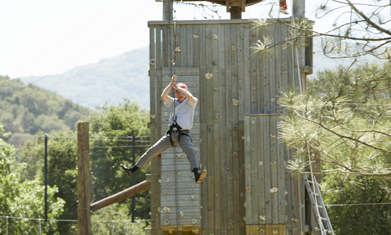Lesson 3
1. Lesson 3
Module 1: Trigonometry
Lesson 3: The Cosine Law
Focus

Sean Murphy/Digital Vision/Thinkstock
There are many instances where direct measurement is not possible. If you can create a triangle using values that can be measured, you can often use trigonometry to calculate the value that is needed.
Jennifer and David are designing an obstacle course. They have a number of different tasks that participants need to complete, and they need to figure out what supplies they need to purchase to set up all of the tasks. They are able to directly measure angles and distances for many of the tasks, but some of them aren’t easily measured directly.
For the first task, people will need to hang on to a rope while crossing a rapidly flowing stream that is about 1 m deep. Jennifer and David need to know the distance across the river to be sure that the rope is long enough. They don’t have a tape measure long enough to measure this, so they decide to create a triangle using measurements they can make in order to calculate this value.
David and Jennifer know the measures of the canyon walls and the angle at the bottom, as shown in the following diagram. The rope corresponds to side f.

You will discover as you work through this lesson how David and Jennifer can determine the value of f.
This lesson will help you answer the following inquiry questions:
- What formulas can be used to solve for angles and sides in any triangle (including oblique triangles)?
- How do you determine when to use the sine law and when to use the cosine law?
Assessment
- Lesson 3 Assignment
All assessment items you encounter need to be placed in your course folder.
Save a copy of the Lesson 3 Assignment to your course folder. You will receive more information about how to complete the assignment later in this lesson.